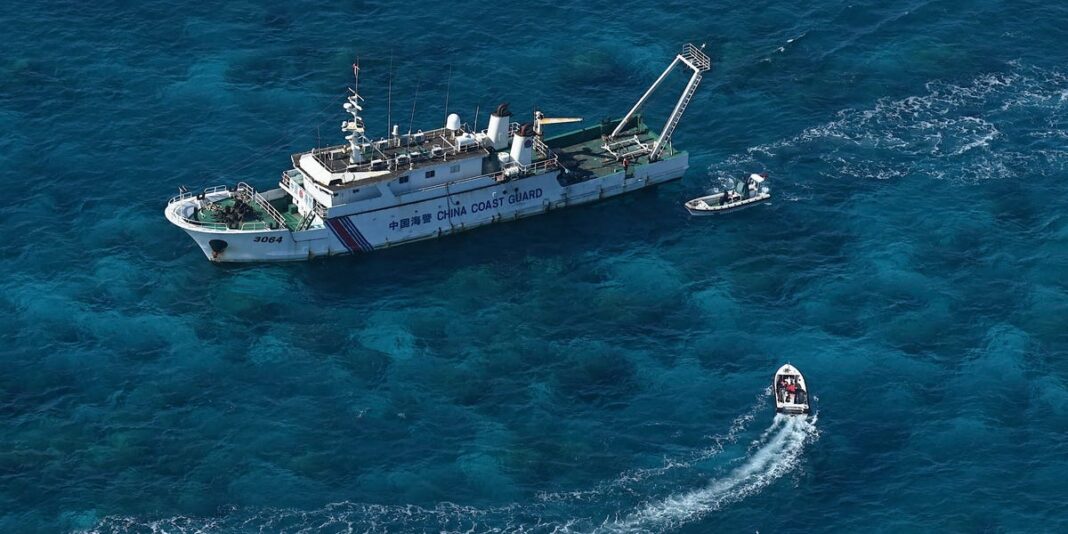- The Philippines’ fisheries bureau said China is trying to “intentionally destroy” the Scarborough Shoal.
- The fish-rich atoll is hotly contested by China, but internationally recognized as Manila’s.
- The bureau on Saturday accused Chinese vessels of pumping cyanide into the shoal’s waters.
The Philippines’ fishing bureau has accused Chinese fishing vessels of using cyanide to destroy the Scarborough Shoal, a fish-rich atoll in the South China Sea contested by both Manila and Beijing.
“These Chinese fishermen use cyanide,” Nazario Briguera, a spokesperson for the Bureau of Fisheries and Aquatic Resources, said on Saturday, per a translation from Filipino by The Philippine Star.
Cyanide fishing is a controversial fishing method that typically involves dumping the highly toxic chemical near coral reefs or in fishing grounds to stun or kill fish so they can be easily captured.
It is widely condemned because it indiscriminately affects most marine species in the area, causes severe damage to aquatic ecosystems, and can make fish harmful to handle or eat.
But Brigeura accused the Chinese fishermen of using cyanide to also “intentionally destroy Bajo de Masinloc to prevent Filipino fishing boats to fish in the area,” per The Philippine Star. Bajo de Masinloc is the Spanish name for the Scarborough Shoal.
The spokesperson estimated that the alleged use of cyanide would result in around $17,850,000 in damages to the region, per the outlet.
The bureau said it has not conducted a formal study of the total damage, but called it a “serious concern,” The Philippine Star reported.
“We will see clearer, and we will have proof or evidence that this is really being done by Chinese fishermen and, apparently, other foreign fishers,” Briguera said, per Philippine outlet GMA News.
However, the Philippine Coast Guard on Sunday said it hadn’t found any evidence of Chinese fishermen using cyanide and could not confirm the fisheries bureau’s accusation.
“We don’t have any scientific study or any evidence that would suggest that cyanide fishing in Bajo de Masinloc can be attributed to the Chinese or the Vietnamese fishermen,” coast guard spokesperson spokesperson Commodore Jay Tarriela said, per GMA News.
Notably, the Philippines’ fishing industry was known to use cyanide fishing back in the 1960s to capture live fish for aquariums and restaurants, though the practice has become less common. In 2023, a study from the Cebu-based Coastal Conservation and Education Foundation found that some Filipino fishermen still use cyanide in the South China Sea.
In response to the accusations, the Chinese state-linked tabloid The Global Times wrote that the Philippines had “groundlessly smeared” China over its cyanide claims. The outlet is known for sticking closely to Beijing’s viewpoints.
The Scarborough Shoal, a pristine atoll that’s now a hotbed for tensions
The Scarborough Shoal has been a focal point for territorial disputes in the South China Sea, and is claimed by China, Taiwan, and the Philippines.
The atoll, abundant with resources, has been used by Filipino fishermen for decades and was claimed by Manila in the 1930s. But China has more recently said that Chinese astronomer Guo Shoujing discovered the shoal in 1279 and that Chinese fishermen have plied the area throughout history.
In 2016, an international tribunal in the Hague overwhelmingly ruled in favor of The Philippines in a case deciding the ownership of the atoll. China rejected the ruling.
Beijing has since patrolled the region with warships and coast guard vessels, establishing de facto control of the atoll and often chasing out Philippine fishermen.
Meanwhile, fishing groups in the Philippines said hundreds of Chinese vessels are entering the region and overfishing its waters. Researchers in Quezon City accused Chinese vessels in 2018 of damaging the atoll so much that the destruction can be seen on Google Earth.
More recently, the Philippines accused China’s coast guard of using “dangerous” maneuvers to harass and block a Philippine ship delivering supplies to fishing vessels.
The Bureau of Fisheries and Aquatic Resources and the Chinese embassy in Manila did not immediately respond to requests for comment from Business Insider.
Source link









